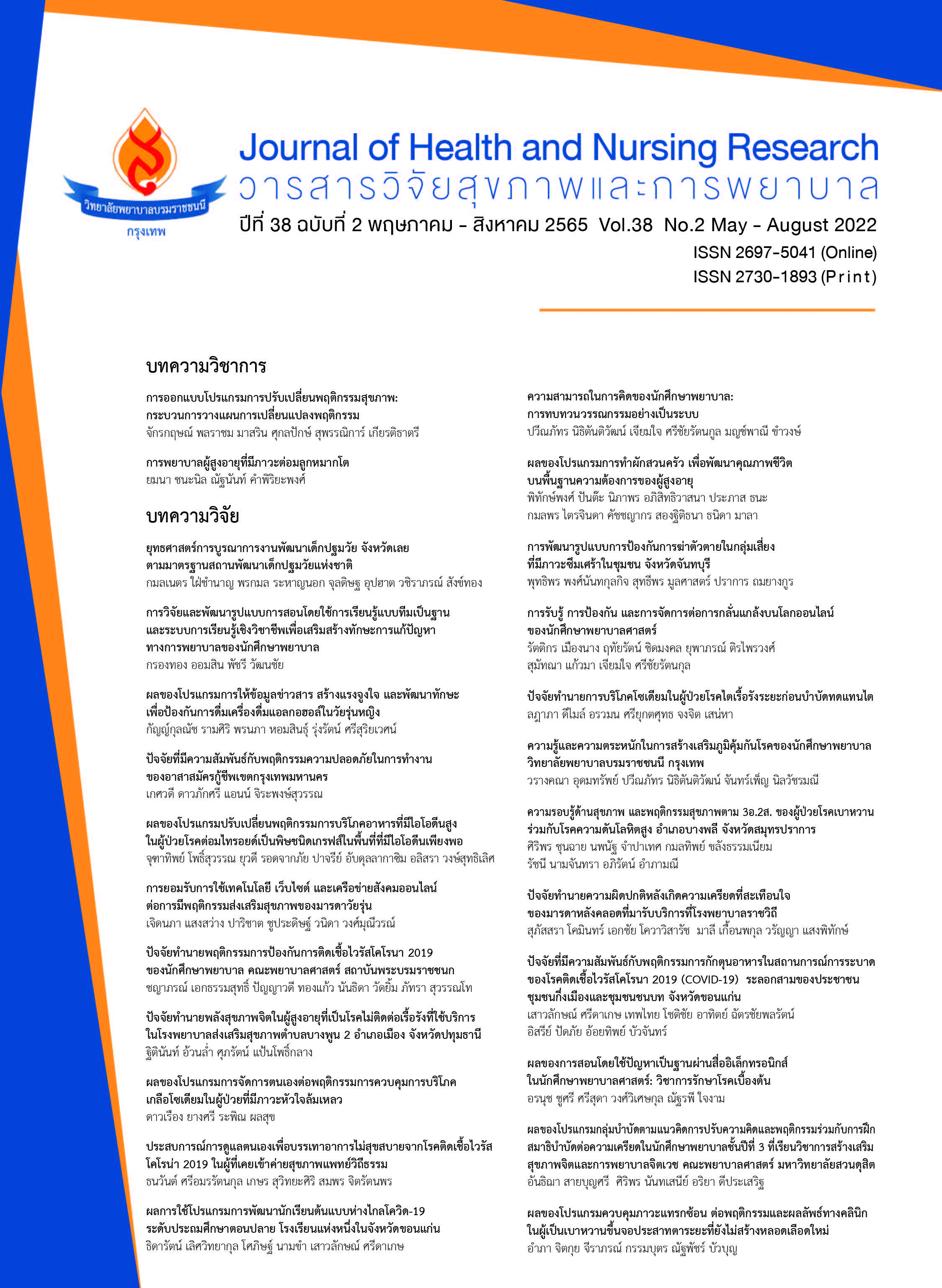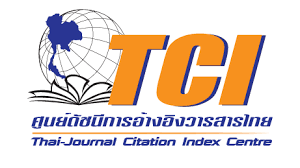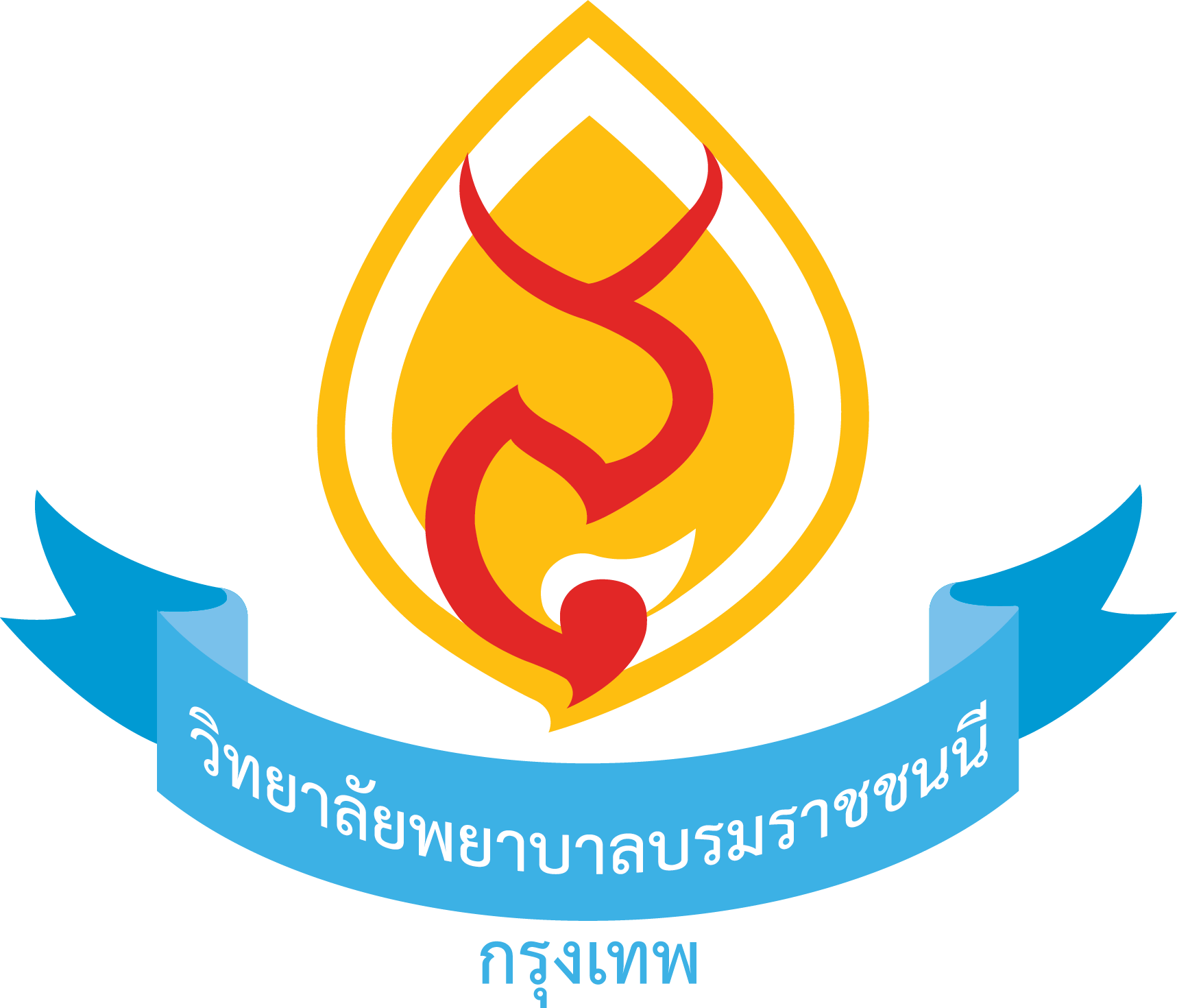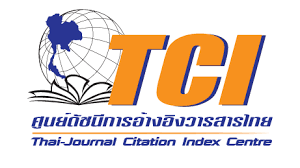ผลของโปรแกรมปรับเปลี่ยนพฤติกรรมการบริโภคอาหารที่มีไอโอดีนสูงในผู้ป่วย โรคต่อมไทรอยด์เป็นพิษชนิดเกรฟส์ในพื้นที่ที่มีไอโอดีนเพียงพอ
คำสำคัญ:
อาหารที่มีไอโอดีนสูง , โรคต่อมไทรอยด์เป็นพิษชนิดเกรฟส์ , พื้นที่ที่มีไอโอดีนเพียงพอบทคัดย่อ
บทนำ: อุบัติการณ์การเกิดโรคต่อมไทรอยด์เป็นพิษชนิดเกรฟส์ในพื้นที่ที่มีไอโอดีนเพียงพอ มีแนวโน้มเพิ่มขึ้นอย่างต่อเนื่อง การให้ความรู้และคำแนะนำในการบริโภคอาหารที่มีไอโอดีนสูงจึงมีความสำคัญ
วัตถุประสงค์การวิจัย: เพื่อศึกษาผลของโปรแกรมปรับเปลี่ยนพฤติกรรมการบริโภคอาหารที่มีไอโอดีนสูงที่ประยุกต์ทฤษฎีการรับรู้ความสามารถตนเอง (Self-efficacy) ในผู้ป่วยโรคต่อมไทรอยด์เป็นพิษชนิดเกรฟส์ในพื้นที่ที่มีไอโอดีนเพียงพอ
ระเบียบวิธีวิจัย: การวิจัยกึ่งทดลองครั้งนี้ เป็นการวัดผลก่อนและหลังการทดลอง ในผู้ป่วยโรคต่อมไทรอยด์เป็นพิษชนิดเกรฟส์ที่เข้ารับการรักษาในโรงพยาบาลมหาวิทยาลัยบูรพา ระหว่างเดือนมีนาคม ถึงเดือนเมษายน 2564 จากการสุ่มแบบเจาะจงและมีพฤติกรรมการบริโภคอาหารที่มีไอโอดีนสูงเป็นประจำ (≥3 ครั้งต่อสัปดาห์) จำนวน 30 คน ได้รับสื่อการเรียนรู้ตามโปรแกรมฯ รูปแบบออนไลน์ เป็นระยะเวลา 4 สัปดาห์ เก็บข้อมูลด้วยแบบสอบถาม และแบบประเมินความถี่พฤติกรรมการบริโภคอาหารที่มีไอโอดีนสูง ที่มีค่าความเชื่อมั่นสัมประสิทธิ์แอลฟาของครอนบราคเท่ากับ .81 และวิเคราะห์ข้อมูลด้วยสถิติ paired t-test
ผลการวิจัย: ภายหลังเข้าร่วมโปรแกรมปรับเปลี่ยนพฤติกรรมการบริโภคอาหารที่มีไอโอดีนสูงพบว่า ค่าเฉลี่ยความรู้เรื่องโรคต่อมไทรอยด์เป็นพิษชนิดเกรฟส์ และอาหารที่มีไอโอดีนสูง การรับรู้ความสามารถตนเอง และความคาดหวังในผลลัพธ์ของกลุ่มตัวอย่างมีค่าสูงขึ้น เมื่อเปรียบเทียบกับก่อนเข้าร่วมโปรแกรมฯ อย่างมีนัยสำคัญทางสถิติ (p<.05) นอกจากนี้ ยังพบว่า ค่าเฉลี่ยความถี่พฤติกรรมการบริโภคอาหารที่มีไอโอดีนสูง
ของผู้ป่วยมีค่าลดลง หลังจากเข้าร่วมโปรแกรมฯ อย่างมีนัยสำคัญทางสถิติ (p<.001)
สรุปผล: ผลการวิจัยครั้งนี้ชี้ให้เห็นว่า โปรแกรมปรับเปลี่ยนพฤติกรรมการบริโภคอาหารที่มีไอโอดีนสูงประยุกต์ทฤษฎีการรับรู้ความสามารถตนเอง สามารถเพิ่มความรู้และช่วยให้พฤติกรรมการบริโภคอาหารที่มีไอโอดีนสูงของผู้ป่วยดีขึ้นได้
ข้อเสนอแนะ: ควรมีการประยุกต์ใช้โปรแกรมปรับเปลี่ยนพฤติกรรมการบริโภคอาหารที่มีไอโอดีนสูง ช่วยเสริมสร้างสุขภาพของผู้ป่วยโรคต่อมไทรอยด์เป็นพิษชนิดเกรฟส์โดยเฉพาะในพื้นที่ที่มีไอโอดีนเพียงพอ เพื่อให้มีพฤติกรรมการบริโภคอาหารที่มีไอโอดีนสูงดีขึ้น
Downloads
เอกสารอ้างอิง
De Leo S, Lee SY, Braverman LE. Hyperthyroidism. Lancet 2016;388(10047):906-918.
Ministry of Public Health. Public health statistics A.D. 2015. Nonthaburi: Strategy and planning division; 2015. (in Thai).
Aghini Lombardi F, Fiore E, Tonacchera M, Antonangeli L, Rago T, Frigeri M, et al. The effect of voluntary iodine prophylaxis in a small rural community: the Pescopagano survey 15 years later. J Clin Endocrinol Metab 2013;98(3):1031-39.
Lou X, Wang X, Wang Z, Mao G, Zhu W, Wang Y, et al. The Effect of Iodine Status on the Risk of Thyroid Nodules: A Cross-Sectional Study in Zhejiang, China. Int J Endocrinol 2020:1-8
Du Y, Gao Y, Meng F, Liu S, Fan Z, Wu J, et al. Iodine deficiency and excess coexist in china and induce thyroid dysfunction and disease: a cross-sectional study. PLoS One. 2014;9(11):111937.
Ershow AG, Skeaff SA, Merkel JM, Pehrsson PR. Development of databases on iodine in foods and dietary supplements. Nutrients 2018;10(1):100.
Bureau of Nutrition, Ministry of Public Health. Report of iodine deficiency disorders prevention and control programme May 2018 to June 2020. Bangkok: Samcharoen Phanich; 2020. (in Thai).
Posuwan J, Rodjarkpai Y, Abdullakasim P, Siriwong S, Aticharoenkul T, Wongsuttilert A. Comparison of knowledge and behavior of high-iodine food consumption among patients with Graves’ disease and healthy adults in iodine-sufficient area. Ramathibodi Medical Journal 2021;44(2):1-10.
Bandura A. Self-efficacy: the exercise of control. New York: W.H. Freeman & Company; 1997.
Bloom B, Engelhart M, Furst E, Hill W, Krathwohl D. Taxonomy of educational objectives: The classification of educational goals. Handbook I: Cognitive domain. New York and Toronto: Longmans, Green; 1956.
Panprapa A, Yovapue S, Chiratiti C, Siriliang B. Consumption of Iodized salt at household level of people at Klongmadua Sub-District, Kratumban District,Smutsakorn Province. Faculty of Public Health Bangkokthonburi University 2014:1-11. (in Thai).
Saotong T, Pichayapinyo P, Lagampan S. Effects of behavior change on glycemic control in type 2 diabetes patients with uncontrolled blood sugar. Journal of Health and Nursing Research 2020;36(3):19-32. (in Thai).
Tantiekkarat S. The Effects of health literacy and social support promotion program among overweight primary school students, Khlong Luang District, Pathumthani Province. Journal of Health and Nursing Research 2020;36(2):50-61. (in Thai).
Polumbryk M, Kravchenko V, Pasichnyi V, Omelchenko C, Pachitskaya I. The effect of intake of sausages fortified with β-CD-I2 complex on iodine status and thyroid function: a preliminary study. J Trace Elem Med Biol 2019; 51:159-63.
Pearce EN. A low-iodine diet during Methimazole treatment worsens graves’ disease outcomes. Clin Thyroidol. 2018;30(2):66–8.
ดาวน์โหลด
เผยแพร่แล้ว
รูปแบบการอ้างอิง
ฉบับ
ประเภทบทความ
สัญญาอนุญาต
ลิขสิทธิ์ (c) 2022 วารสารวิจัยสุขภาพและการพยาบาล (วารสารวิทยาลัยพยาบาลบรมราชชนนี กรุงเทพ)

อนุญาตภายใต้เงื่อนไข Creative Commons Attribution-NonCommercial 4.0 International License.
บทความที่ได้รับการตีพิมพ์ เป็นลิขสิทธิ์ของวารสารวิจัยสุขภาพและการพยาบาล (วิทยาลัยพยาบาลบรมราชชนนี กรุงเทพ) ไม่สามารถนำไปตีพิมพ์ซ้ำในวารสารฉบับอื่น


















